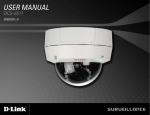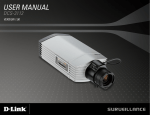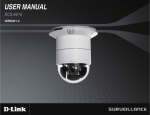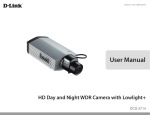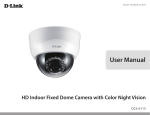Download D-Link DCS-6511 User manual
Transcript
Table of Contents Product Overview......................................................... 4 Package Contents.................................................... 4 Installation..................................................................... 5 Hardware Overview.................................................. 5 Camera Enclosure Disassembly and SD Card Installation................................................................ 6 Hardware Reset........................................................ 7 Preparing for Installation........................................... 8 Adjusting the Viewing Angle................................... 11 Standard Mounting Instructions.............................. 12 Style 1 - Concealed Cable Installation.............. 12 Style 2 - Exposed Cable Installation................. 14 Pendant Mount (DCS-34-2).................................... 16 Bent Mount (DCS-34-3).......................................... 18 Network and Power Connections........................... 20 Configuration.............................................................. 21 Configuration with Wizard....................................... 21 Web-based Configuration Utility............................. 26 D-ViewCam Setup Wizard................................ 28 Live Video............................................................... 30 Setup...................................................................... 32 Wizard............................................................... 32 Internet Connection Setup Wizard.................... 32 Motion Detection Setup Wizard........................ 35 Network Setup.................................................. 37 Dynamic DNS................................................... 39 D-Link DCS-6511 User Manual Image Setup..................................................... 40 Audio and Video............................................... 42 Lens Control..................................................... 44 Motion Detection............................................... 45 Time and Date.................................................. 46 Event Setup...................................................... 47 Application........................................................ 48 Add Server........................................................ 49 Add Media......................................................... 50 SD Card............................................................ 55 Advanced................................................................ 56 Digital Input/Output........................................... 56 ICR and IR........................................................ 57 HTTPS.............................................................. 58 Access List........................................................ 59 Maintenance........................................................... 60 Device Management......................................... 60 Backup and Restore......................................... 61 Firmware Upgrade............................................ 62 Status..................................................................... 63 Device Info........................................................ 63 Logs.................................................................. 64 Help.................................................................. 65 Appendix..................................................................... 66 DI/DO Schematics.................................................. 66 Technical Specifications......................................... 67 2 Preface D-Link reserves the right to revise this publication and to make changes in the contents hereof without obligation to notify any person or organization of such revisions or changes. Manual Revisions Revision Date Description 1.0 September 30, 2010 2.0 June 20, 2011 DCS-6511 Revision A1 with firmware version 1.00 DCS-6511 Revision A1 CD integration Trademarks D-Link and the D-Link logo are trademarks or registered trademarks of D-Link Corporation or its subsidiaries in the United States or other countries. All other company or product names mentioned herein are trademarks or registered trademarks of their respective companies. Copyright © 2010-2011 by D-Link Systems, Inc. All rights reserved. This publication may not be reproduced, in whole or in part, without prior expressed written permission from D-Link Systems, Inc. D-Link DCS-6511 User Manual 3 Product Overview Package Contents DCS-6511 Network Camera Power Adapter Security Wrench A/V & Power Cables Manual and Wizard on CD-ROM Quick Installation Guide CAT-5 Ethernet Cable Extension Adapter Mounting Bracket and Screws Cable Cover Rubber Plug If any of the above items are missing, please contact your reseller. D-Link DCS-6511 User Manual 4 Installation Hardware Overview Infrared LEDs Used to illuminate the camera's field of view at night Camera Lens Motorized varifocal autofocus lens D-Link DCS-6511 User Manual 5 Installation Camera Enclosure Disassembly and SD Card Installation Disassemble the Camera Open the camera enclosure by removing the 3 standard screws using a screwdriver. Remove the 4th screw using the provided security wrench. Lift the dome off of the base of the camera. Figure A. Install the SD Card Push the SD card into the camera with the gold contacts oriented towards the base of the camera. To eject the SD card, push the SD card into the slot. Figure B. D-Link DCS-6511 User Manual 6 Installation Hardware Reset Resetting the Camera If the camera is malfunctioning, you may use the hardware reset button located on the underside of the camera apparatus to reset the camera to factory default settings. Press and hold the reset button for approximately 10 seconds to reset the camera. Reset Button Resets camera to factory default settings Figure C. D-Link DCS-6511 User Manual 7 Installation Preparing for Installation A. Depending on how you choose to mount the camera, you may need to change the orientation of the cable. For instance, when using the Surface Mounting Bracket, the cables may need to exit through the side of the camera base rather than the top. Changing Cable Orientation: 1. Disassemble the camera enclosure. (See Figure A. on page 6.) 2. Loosen, but do not remove, the two screws that secure the camera bracket to the base of the enclosure using a screwdriver. (Figure 1.1) 3. Slide the camera bracket towards the front of the camera base. (Figure 1.2) Figure 1.1 Figure 1.2 D-Link DCS-6511 User Manual 8 Installation 4. Lift the camera bracket up and off from the camera base. (Figure 1.3) 5. Disconnect the cables from the connectors at the base of the camera. 6. Place the cable into the new hole and reconnect the cables to the cable connectors at the base of the camera. (Figure 1.4) 7. Replace the chrome plug and tighten it into place. 8. Replace the chrome nut and tighten it into place B. Replace the dome enclosure over the IP camera and tighten the 4 screws. Figure 1.3 Safety Notice: Installation and servicing should be done by certified technicians so as to conform to all local codes and prevent voiding your warranty. D-Link DCS-6511 User Manual 9 Installation 24 V Power Connector Connects to 24 V AC power 12 V Power Connector Connects to 12 V DC Power adapter Figure 1.4 Ethernet Jack RJ-45 connector for Ethernet which can also be used to power the camera using Power over Ethernet (PoE) D-Link DCS-6511 User Manual Audio In Connects to a microphone Audio Out Connects to speakers DI/DO Wiring, 12V DC output I/O connectors for external devices 10 Installation Adjusting the Viewing Angle Adjust the Viewing Angle of the 3-Axis Mechanism Turn the lens module left and right until the desired position is achieved; tighten the pan screw once completed. Loosen the tilt screws on both sides of the camera, and turn the lens module up and down until the desired position is achieved; tighten the tilt screws once completed. Turn the lens to adjust the IP camera’s image until the desired orientation is achieved. Tighten the image adjustment screw once completed. D-Link DCS-6511 User Manual 11 Installation Standard Mounting Instructions Style 1 - Concealed Cable Installation 1. Disassemble the camera enclosure (see page 6). 2. Thread the cables through the waterproof plugs at the bottom of the base of the camera. Attach the cables to the corresponding cable connectors. (Figure 2.1) 3. Locate a suitable position on the ceiling for the mounting plate to be installed. 4. Use the mounting template to mark the holes for installation. 5. Cut an access hole in the ceiling for the cables. 6. Drill four separate 6 mm holes corresponding to the holes in the mounting template and insert the plastic anchors into these holes. 7. Attach the surface bracket to the ceiling using the screws provided. Figure 2.1 D-Link DCS-6511 User Manual 12 Installation 8. Connect the Ethernet cable and the power cable, threading them through the hole in the ceiling. (Figure 2.2) 9. Push the dome body up over the base of the camera. 10. Attach the dome to the base of the camera using the 3 long screws and the provided security screw. Figure 2.2 D-Link DCS-6511 User Manual 13 Installation Style 2 - Exposed Cable Installation 1. Disassemble the camera enclosure (see page 6). 2. Remove the small screw to release the faceplate on the side of the base of the camera. (Figure 2.3) 3. Thread the cables through the waterproof plugs on the side of the base of the camera. Attach the cables to the corresponding cable connectors. (See page 10.) 4. Attach the dual-holed plate to the base of the camera. (Figure 2.4) Figure 2.3 Figure 2.4 D-Link DCS-6511 User Manual 14 Installation 5. Place the plastic cable cover onto the dual-holed plate and attach it using the screw. (Figure 2.5) 6. Locate a suitable position on the ceiling for the mounting plate to be installed. 7. Use the mounting template to mark the holes for installation. Figure 2.5 8. Drill 4 separate 6 mm holes corresponding to the holes in the mounting template and insert the plastic anchors into these holes. 9. Attach the surface bracket to the ceiling using the screws provided. 10. Place the dome body onto the base of the camera. (Figure 2.6) 11. Attach the dome to the base of the camera using the 3 long screws and the provided security screw. Figure 2.6 D-Link DCS-6511 User Manual 15 Installation Pendant Mount (DCS-34-2) Bracket Cap 1. Attach the mounting plate to the bracket cap using the three screws as shown in Figure 3.1. 2. Locate a suitable position on the ceiling for a 34 mm (+2 / –0 mm) hole to be cut. A template is included to aid in marking the mounting hole. 3. Cut the hole in the ceiling according to the template. Mounting Plate 4. Drill 4 separate 6 mm holes corresponding to the holes in the mounting template and insert the plastic anchors into these holes. 5. Place the rubber seal between the pendant bracket and the ceiling to ensure a waterproof seal between the ceiling and the bracket. (Figure 3.2) Figure 3.1 6. Attach the pendant bracket to the ceiling using the screws provided. 7. Attach the bracket cap to the bottom of the pendant bracket, rotating the cap counter-clockwise to tighten it into place. Rubber Seal Pendant Bracket 8. Insert the screw into the base of the pendant bracket at the top of the bracket cap to secure the bracket cap into place. Bracket Cap Figure 3.2 D-Link DCS-6511 User Manual 16 Installation 9. Connect the Ethernet cable and the power cable and thread them through the pendant bracket. 10.Place the dome body onto the base of the camera. (Figure 3.3) 11. Attach the dome to the base of the camera using the 3 long screws and the provided security screw. Figure 3.3 Figure 3.4 D-Link DCS-6511 User Manual 17 Installation Bent Mount (DCS-34-3) Bracket Cap 1. Attach the mounting plate to the bracket cap using the three screws as shown in Figure 4.1. 2. Locate a suitable position on the ceiling for a 34 mm (+2 / –0 mm) hole to be cut. A template is included to aid in marking the mounting hole. 3. Cut the hole in the ceiling according to the template Mounting Plate 4. Drill 4 separate 6 mm holes corresponding to the holes in the mounting template and insert the plastic anchors into these holes. 5. Place the rubber seal between the bent bracket and the ceiling to ensure a waterproof seal between the ceiling and the bracket. (Figure 4.2) Figure 4.1 6. Attach the pendant bracket to the ceiling using the screws provided. 7. Attach the bracket cap to the bottom of the bent bracket, rotating the cap counterclockwise to tighten it into place. Bent Bracket 8. Insert the screw into the base of the bent bracket at the top of the bracket cap to secure the bracket cap into place. 9. Connect the Ethernet cable and the power cable and thread them through the pendant bracket. D-Link DCS-6511 User Manual Figure 4.2 Bracket Cap 18 Installation 10. Place the dome body onto the base of the camera. (Figure 4.3) 11. Attach the dome to the base of the camera using the 3 long screws and the provided security screw. Bent Bracket Dome Camera Figure 4.3 Figure 4.4 D-Link DCS-6511 User Manual 19 Installation Network and Power Connections General Connection Using 12 V DC Power Adapter 1.Connect the network camera to a hub via an Ethernet cable. 2.Connect the supplied power cable from the camera to a power outlet. General Connection Using 24 V AC Power Wiring 1.Connect the network camera to a hub via an Ethernet cable. 2.Connect the supplied power cable from the camera to a power source such as your building's emergency power. Connection with a PoE Hub If you are using a PoE hub, connect the IP camera to the hub via an Ethernet cable, which will provide transmission of both power and data over a single cable. D-Link DCS-6511 User Manual 20 Configuration Configuration with Wizard Insert the DCS-6511 CD into your computer's CD-ROM drive to begin the installation. If the Autorun function on your computer is disabled, or if the D-Link Launcher fails to start automatically, click Start > Run. Type D:\autorun.exe, where D: represents the drive letter of your CD-ROM drive. Click Setup Wizard to begin the installation. Click Next to continue. D-Link DCS-6511 User Manual 21 Configuration Click Yes to accept the License Agreement. To start the installation process, click Next. Note: The installation may take several minutes to finish. D-Link DCS-6511 User Manual 22 Configuration Click Finish to complete the installation. Click on the D-Link Setup Wizard SE icon that was created in your Windows Start menu. Start > D-Link > Setup Wizard SE D-Link DCS-6511 User Manual 23 Configuration The Setup Wizard will appear and display the MAC address and IP address of your camera(s). If you have a DHCP server on your network, a valid IP Address will be displayed. If your network does not use a DHCP server, the network camera's default static IP address 192.168.0.20 will be displayed. Click the Wizard button to continue. Enter the Admin ID and password. When logging in for the first time, the default Admin ID is admin with the password left blank. Click Next, to proceed to the next page. D-Link DCS-6511 User Manual 24 Configuration Select DHCP if your camera obtains an IP address automatically when it boots up. Select Static IP if the camera will use the same IP address each time it is started. Click Next, to proceed to the next page. Take a moment to confirm your settings and click Restart. D-Link DCS-6511 User Manual 25 Configuration Web-based Configuration Utility This section explains how to configure your new D-Link Network Camera using the Web-based Configuration Utility. Click on the D-Link Setup Wizard SE icon that was created in your Windows Start menu. Start > D-Link > Setup Wizard SE Select the camera and click the button labeled "Link" to access the web configuration. The Setup Wizard will automatically open your web browser to the IP address of the camera. Alternatively, you may manually open a browser and enter the IP address of the camera: 192.168.0.20 D-Link DCS-6511 User Manual 26 Configuration Enter admin as the default username and leave the password blank. Click OK to continue. This section shows your camera’s live video. You can select your video profile and view or operate the camera. For additional information about web configuration, please refer to the user manual included on the CD-ROM or the D-Link website. D-Link DCS-6511 User Manual 27 Configuration D-ViewCam Setup Wizard D-ViewCam software is included for the administrator to manage multiple D-Link IP cameras remotely. You may use the software to configure all the advanced settings for your cameras. D-ViewCam is a comprehensive management tool for IP surveillance. Insert the CD-ROM into the CD-ROM drive. Click "Install D-ViewCam Software" from menu, and select "D-ViewCam" to install the VMS software. Follow the Installation Wizard to install D-ViewCam. D-Link DCS-6511 User Manual 28 Configuration Click Finish to complete the installation. To start D-ViewCam, select Start > All Programs > D-Link D-ViewCam > Main Console. For more detail operation of using D-ViewCam software, please refer to D-ViewCam Manual. D-Link DCS-6511 User Manual 29 Configuration Live Video This section shows your camera’s live video. You may select any of the available icons listed below to operate the camera. You may also select your language using the drop-down menu on the left side of the screen. Digital Input Indicator Motion Trigger Indicator This indicator will change color when a digital input signal is detected. This indicator will change color when a trigger event occurs. Recording Indicator Note: The video motion feature for your camera must be enabled. When a recording is in progress, this indicator will change color. Video Profile 1 Video Profile 2 Video Profile 3 Full screen mode Taking a Snapshot Recording a Video Clip Set a Storage Folder Listen/Stop Listening Talk/Stop Talking Start/Stop Digital Output D-Link DCS-6511 User Manual Control Pad This control pad can be used to pan, tilt, and zoom within the camera's predefined view area, if one has been defined. 30 Configuration Go To: If any presets have been defined, selecting a preset (Preset List) from this list will display it. SD Status: This option displays the status of the SD card. If no SD card has been inserted, this screen will display the message "Card Invalid." IO Status: This option displays the status of your I/O device if a device has been connected. PTZ Control: This camera uses electronic pan/tilt/zoom (ePTZ) to select and view areas of interest in the field of view. Please see page 42 for information about setting the frame size and view window area. ePTZ Speed: You may select a value between 0 and 64. 0 is the slowest and 64 is the fastest. Global View: This window indicates the total field of view (FOV) of the camera. The red box indicates the visible region of interest (ROI). Language: You may select the interface language using this menu. The available options are English and Traditional Chinese. D-Link DCS-6511 User Manual Auto Pan Starts the automatic panning function. The ROI will pan from back and forth within the FOV Stop Stops the camera ePTZ motion Preset Path Starts the camera's motion along the predefined path 31 Configuration Setup Wizard To configure your Network Camera, click Internet Connection Setup Wizard. Alternatively, you may click Manual Internet Connection Setup to manually configure your Network Camera and skip to page 22. To quickly configure your Network Camera’s motion detection settings, click Motion Detection Setup Wizard. If you want to enter your settings without running the wizard, click Manual Motion Detection Setup and skip to page 27. Internet Connection Setup Wizard This wizard will guide you through a step-by-step process to configure your new D-Link Camera and connect the camera to the internet. Click Next to continue. Note: Select DHCP if you are unsure of which settings to choose. Click Next to continue. D-Link DCS-6511 User Manual 32 Configuration Select Static IP if your Internet Service Provider has provided you with connection settings, or if you wish to set a static address within your home network. Enter the correct configuration information and click Next to continue. If you are using PPPoE, select Enable PPPoE and enter your user name and password, otherwise click Next to continue. If you have a Dynamic DNS account and would like the camera to update your IP address automatically, Select Enable DDNS and enter your host information. Click Next to continue. Enter a name for your camera and click Next to continue. D-Link DCS-6511 User Manual 33 Configuration Configure the correct time to ensure that all events will be triggered as scheduled. Click Next to continue. If you have selected DHCP, you will see a summary of your settings, including the camera's IP address. Please write down all of this information as you will need it in order to access your camera. Click Apply to save your settings. D-Link DCS-6511 User Manual 34 Configuration Motion Detection Setup Wizard This wizard will guide you through a step-by-step process to configure your camera's motion detection functions. Click Next to continue. Step 1 This step will allow you to enable or disable motion detection, specify the detection sensitivity, and adjust the camera’s ability to detect movement. You may specify whether the camera should capture a snapshot or a video clip when motion is detected. Please see the Motion Detection section on page 45 for information about how to configure motion detection. Step 2 This step allows you to enable motion detection based on a customized schedule. Specify the day and hours. You may also choose to always record motion. D-Link DCS-6511 User Manual 35 Configuration Step 3 This step allows you to specify how you will receive event notifications from your camera. You may choose not to receive notifications, or to receive notifications via e-mail or FTP. Please enter the relevant information for your e-mail or FTP account. Click Next to continue. Step 4 You have completed the Motion Detection Wizard. Please verify your settings and click Apply to save them. Please wait a few moments while the camera saves your settings and restarts. D-Link DCS-6511 User Manual 36 Configuration Network Setup Use this section to configure the network connections for your camera. All relevant information must be entered accurately. LAN Settings: Settings for your local area network. DHCP: Select this connection if you have a DHCP server running on your network and would like your camera to obtain an IP address automatically. Static IP Address: You may obtain a static or fixed IP address and other network information from your network administrator for your camera. A static IP address may simplify access to your camera in the future. IP Address: Enter the fixed IP address in this field. Subnet Mask: This number is used to determine if the destination is in the same subnet. The default value is 255.255.255.0. Default Gateway: The gateway used to forward frames to destinations in a different subnet. Invalid gateway settings may cause the failure of transmissions to a different subnet. Primary DNS: The primary domain name server translates names to IP addresses. Secondary DNS: The secondary DNS acts as a backup to the primary DNS. Enable UPnP: Enabling this setting allows your camera to be configured as a UPnP device on your network. Enable UPnP Port Enabling this setting allows the camera to add port forwarding entries into the router automatically on Forwarding: a UPnP capable network. D-Link DCS-6511 User Manual 37 Configuration Enable PPPoE: Enable this setting if your network uses PPPoE. User Name: The unique name of your account. You may obtain this information from your ISP. Password: The password to your account. You may obtain this information from your ISP. HTTP Port: The default port number is 80. Access Name for Stream 1~3: The default name is video#.mjpg, where # is the number of the stream. HTTPS Port: You may use a PC with a secure browser to connect to the HTTPS port of the camera. The default port number is 443. RTSP Port: The port number that you use for RTSP streaming to mobile devices, such as mobile phones or PDAs. The default port number is 554. You may specify the address of a particular stream. For instance, live1.sdp can be accessed at rtsp://x.x.x.x/video1.sdp where the x.x.x.x represents the ip address of your camera. Maximum Upload/Download Specifying the maximum download/upload Bandwidth: bandwidth for each socket can be useful when connecting your device to a busy or heavily loaded network. Entering a value of '0' indicates that the camera should not monitor bandwidth. Specifying other values will limit the camera's transfer speed to the specified number of Kilobytes per second. D-Link DCS-6511 User Manual 38 Configuration Dynamic DNS DDNS (Dynamic Domain Name Server) will hold a DNS host name and synchronize the public IP address of the modem when it has been modified. A user name and password are required when using the DDNS service. Enable DDNS: Select this checkbox to enable the DDNS function. Server Address: Select your Dynamic DNS provider from the dropdown menu or enter the server address manually. Host Name: Enter the host name of the DDNS server. User Name: Enter your user name or e-mail used to connect to the DDNS. Password: Enter your password used to connect to the DDNS server. Timeout: Enter DNS Timeout values. Status: Indicates the connection status, which is automatically determined by the system. D-Link DCS-6511 User Manual 39 Configuration Image Setup In this section, you may configure the video image settings for your camera. A preview of the image will be shown in Live Video. Enable Privacy Mask: The Privacy Mask setting allows you to specify up to 3 rectangular areas on the camera's image to be blocked/excluded from recordings and snapshots. You may click and drag the mouse cursor over the camera image to draw a mask area. Right clicking on the camera image brings up the following menu options: Disable All: Disables all mask areas Enable All: Enables all mask areas Reset All: Clears all mask areas. Mirror: Mirrors the images. Flip: Rotates the image 180 degrees. White Balance: If this option is enabled, white objects will be rendered as white on the screen. Exposure Mode: Changes the exposure mode. Use the dropdown box to set the camera for Indoor, Outdoor, or Night environments, or to capture Moving objects. The Low_Noise option will focus on creating a high-quality picture without noise. You can also create 3 different custom exposure modes. The Max Gain setting will allow you to control the maximum amount of gain to apply to brighten the picture. Denoise: This setting controls the amount of noise reduction that will be applied to the picture. Brightness: Adjust this setting to compensate for backlit subjects. Contrast: Adjust this setting to alter the color intensity/strength. Saturation: This setting controls the amount of coloration, from grayscale to fully saturated. D-Link DCS-6511 User Manual 40 Configuration Sharpness: Specify a value from 0 to 8 for image edge enhancement. WDR Level: Adjust the wide dynamic range level from 0 to 8; higher settings are better for high-contrast environments. Reset Default: Click this button to reset the image to factory default settings. D-Link DCS-6511 User Manual 41 Configuration Audio and Video You may configure 3 video profiles with different settings for your camera. Hence, you may set up different profiles for your computer and mobile display. In addition, you may also configure the two-way audio settings for your camera. Higher frame size, frame rate and bit rate rate gives better video quality. At the same time, it requires more network bandwidth. Resolution: This option allows the user to choose the video resolution of the camera between 160x120, 320x240, 640x480, 1280x720, 1280x1024: • QQVGA @ 160x120 - Typically used on handheld devices. • QVGA @ 320x240 - Standard resolution for mobile phones and PDAs. • VGA @ 640x480 - Standard resolution for computer displays. • 720P @ 1280x720 - Typically used on handheld devices. • SXGA @ 1280x1024 - Standard resolution for computer displays. Mode: Select the video compression mode. You may select JPEG, MPEG4, or H.264. H.264 consumes less network bandwidth than JPEG. Frame Size: Select the frame size. 5 options exist for the sizes of the video display. 160x120 is recommended for mobile viewing and 1280x1024 is recommended for computer viewing. View Window Area: Select the size for the view window. Be sure to set the view window area to equal or smaller than the frame size so that the EPTZ system functions correctly. Maximum Frame Rate: A higher frame rate provides smoother motion for videos. Lower frame rates will result in stuttering motion. The maximum number of frames that is displayed in 1 second. 30 fps is the highest video quality for this camera. In general, any frame rate above 15 fps is imperceptible to the human eye. D-Link DCS-6511 User Manual 42 Configuration Video Quality: This limits the maximal refresh frame rate, which can be combined with the "Fixed quality" option to optimize the bandwidth utilization and video quality. If fixed bandwidth utilization is desired regardless of the video quality, choose "Constant bit rate" and select the desired bandwidth. Constant Bit Rate: The bps will affect the bit rate of the video recorded by the camera. Higher bit rates result in higher video quality. JPEG Quality: Select the image quality level of JPEG images. You may choose Standard, Good, or Excellent. Audio in off: Select this box to turn off the audio input (microphone). Audio in gain level: Choose the gain level. You may select 0 dB or 26 dB. Audio out off: Select this box to turn off the audio output (speaker). Audio out volume level: Select a level between 1 (lowest) and 10 (highest) for the audio out. D-Link DCS-6511 User Manual 43 Configuration Lens Control The red rectangular frame can be moved within the live image of this setting page. The camera will automatically adjust the focus based on the region of interest indicated by the red frame. Focus Mode: You may select Auto to allow the camera to automatically adjust the focus. You may select Manual focus to adjust the focus using the focus slider. Lens Zoom Speed: Select a speed between 1 and 10 for the camera's optical zoom feature. Zoom: Use the slider bar to adjust the zoom level. Focus: When Manual focus is selected, you may use this slider bar to adjust the focus level. D-Link DCS-6511 User Manual 44 Configuration Motion Detection Enabling Video Motion will allow your camera to use the motion detection feature. You may draw a finite motion area that will be used for monitoring. Enable Video Motion: Select this box to enable the motion detection feature of your camera. Sensitivity: Specifies the measurable difference between two sequential images that would indicate motion. Please enter a value between 0 and 100. Percentage: Specifies the amount of motion in the window being monitored that is required to initiate an alert. If this is set to 100%, motion is detected within the whole window will trigger a snapshot. Draw Motion Area: Draw the motion detection area by dragging your mouse in the window (indicated by the red square). Erase Motion Area: To erase a motion detection area, simply click on the red square that you wish to remove. Right clicking on the camera image brings up the following menu options: Select All: Draws a motion detection area over the entire screen. Clear All: Clears any motion detection areas that have been drawn. Restore: Restores the previously specified motion detection areas. D-Link DCS-6511 User Manual 45 Configuration Time and Date This section allows you to automatically or manually configure, update, and maintain the internal system clock for your camera. Time Zone: Select your time zone from the drop-down menu. Enable Daylight Saving: Select this to enable Daylight Saving Time. Auto Daylight Saving: Select this option to allow your camera to configure the Daylight Saving settings automatically. Set Date and Time Manually: Selecting this option allows you to configure the Daylight Saving date and time manually. Offset: Sets the amount of time to be added or removed when Daylight Saving is enabled. Synchronize with NTP Server: Enable this feature to obtain time automatically from an NTP server. NTP Server: Network Time Protocol (NTP) synchronizes the DCS-6511 with an Internet time server. Choose the one that is closest to your location. Set the Date and Time Manually: This option allows you to set the time and date manually. Copy Your Computer's Time Settings: This will synchronize the time information from your PC. D-Link DCS-6511 User Manual 46 Configuration Event Setup The Event Setup page includes four different sections. • Event • Server • Media • Recording 1. To add a new item - "event, server or media," click Add. A screen will appear and allow you to update the fields accordingly. 2. To delete the selected item from the drop-down menu of event, server or media, click Delete. 3. Click on the item name to pop up a window for modifying. Note: You can add up to four events, five servers, and five media fields. D-Link DCS-6511 User Manual 47 Configuration Application In a typical application, when motion is detected, the DCS-6511 Network Camera sends images to a FTP server or via e-mail as notifications. As shown in the illustration below, an event can be triggered by many sources, such as motion detection or external digital input devices. When an event is triggered, a specified action will be performed. You can configure the Network Camera to send snapshots or videos to your e-mail address or FTP site. Action Event Condition ex. Motion detection, Periodically, Digital input, System reboot Media (what to send) ex. Snapshot, Video Clips Server (where to send) ex. Email, FTP To start plotting an event, it is suggested to configure server and media columns first so that the Network Camera will know what action shall be performed when a trigger is activated. D-Link DCS-6511 User Manual 48 Configuration Add Server Configure up to 5 servers to store media. Server Name: Enter the unique name of your server. E-mail: Enter the configuration for the target e-mail server account. FTP: Enter the configuration for the target FTP server account. Network Storage: Specify a network storage device. Only one network storage device is supported. SD Card: Use the camera's onboard SD card storage. D-Link DCS-6511 User Manual 49 Configuration Add Media There are three types of media, Snapshot, Video Clip and System Log. Media Name: Enter a unique name for media. Snapshot: Select this option to enable snapshots. Source: The stream source: Profile 1, Profile 2 or Profile 3. Send pre-event image(s) [0~4]: The number of pre-event images. Send post-event image(s) [0~7]: The number of post-event images. File name prefix: The prefix name will be added on the file name. Add date and time suffix to file name: Check it to add timing information as file name suffix. Video clip: Select this option to enable video clips. Source: The source of the profile: profile1, profile2, or profile3. Pre-event recording: The interval of pre-event recording in seconds. Maximum duration: The maximal recording file duration in seconds. Maximum file size: The maximal file size would be generated. File name prefix: The prefix name will be added on the file name of the video clip. System log: Select this option to save events to the camera system log. D-Link DCS-6511 User Manual 50 Configuration Send post-event image (s) [0~7) Specify to capture the number of images after a trigger is activated. A maximum of seven images can be generated. For example: If both the Send pre-event images and Send post-event images are set to four, a total of 9 images are generated after a trigger is activated. 1 pic. 2 pic. 3 pic. 4 pic. 5 pic. 6 pic. 7 pic. 8 pic. 9 pic. The moment the trigger is activated. Add a date and time suffix to the file name Select this option to add a date and time to the file name suffix. SNAPSHOTS20080104_100341 File name prefix Date and time suffix The format is: YYYYMMDD_HHMMSS Maximum duration Specify the maximal recording duration in seconds. You can set up to ten seconds. For example: D-Link DCS-6511 User Manual 51 Configuration If the Pre-event recording is set to five seconds and the Maximum duration is set to ten seconds, the Network Camera continues to record for another four seconds after a trigger is activated. 1 sec. 2 sec. 3 sec. 4 sec. 5 sec. 6 sec. 7 sec. 8 sec. 9 sec. 10 sec. The moment the trigger is activated. File name prefix Enter the text that will be added at the beginning of the file name. VIDEOS20080104_100341 File name prefix Date and time suffix The format is: YYYYMMDD_HHMMSS D-Link DCS-6511 User Manual 52 Configuration Add Event Create and schedule up to three events with their own settings here. Event name: Enter a name for the event. Enable this event: Select this box to activate this event. Priority: Set the priority for this event. The event with higher priority will be executed first. Delay: Select the delay time before checking the next event. It is being used for both events of motion detection and digital input trigger. Trigger: Specify the input type that triggers the event. Video Motion Motion is detected during live video monitoring. Select Detection: the windows that need to be monitored. Periodic: The event is triggered in specified intervals. The trigger interval unit is in minutes. Digital Input: The external digital input trigger input to the camera. System Boot: Triggers an event when the system boots up. Network Lost: Triggers and event when the network is lost. Time: Select Always or enter the time interval. Trigger D/O: Select to trigger the digital output for a specific number of seconds when an event occurs. D-Link DCS-6511 User Manual 53 Configuration Add Recording Here you can configure and schedule the recording settings. Recording entry name: The unique name of the entry. Enable this recording: Select this to enable the recording function. Priority: Set the priority for this entry. The entry with a higher priority value will be executed first. Source: The source of the stream. Recording schedule: Scheduling the recording entry. Recording settings: Configuring the setting for the recording. Destination: Select the folder where the recording file will be stored. Total cycling Please input a volume size between 1MB and 200GB for recording space. The recording data will replace the recording size: oldest record when the total recording size exceeds this value. For example, if each recording file is 6MB, and the total cyclic recording size is 600MB, then the camera will record 100 files in the specified location (folder) and then will delete the oldest file and create new file for cyclic recording. Please note that if there is not enough free space, the recording will stop. Before you set up this option please make sure that sufficient free space is available. It is better to not save other files in the same folder as recordings. Size of each file for recording: File size for each recording file. You may input the value in the range of 200-5000. File Name Prefix: The prefix name will be added on the file name of the recording file(s). D-Link DCS-6511 User Manual 54 Configuration SD Card Here you may browse and manage the recorded files which are stored on the SD card. Format SD Card: Click this icon to automatically format the SD card and create "picture" & "video" folders. View Recorded Picture: If the picture files are stored on the SD card, click on the picture folder and choose the picture file you would like to view. Playback Recorded Video: If video files are stored on the SD card, click on the video folder and choose the video file you would like to view. Refresh: Reloads the file and folder information from the SD card. D-Link DCS-6511 User Manual 55 Configuration Advanced Digital Input/Output This screen allows you to control the behavior of digital input and digital output devices. The I/O connector provides the physical interface for digital output (DO) and digital input (DI) that is used for connecting a diversity of external alarm devices such as IR-Sensors and alarm relays. The digital input is used for connecting external alarm devices and once triggered images will be taken and e-mailed. Select D/I or D/O Mode: The camera will send a signal when an event is triggered, depending upon the type of device connected to the DI circuit. N.C. stands for Normally Closed. This means that the normal state of the circuit is closed. Therefore events are triggered when the device status changes to Open. N.O. stands for Normally Open. This means that the normal state of the circuit is open. Therefore events are triggered when the device status changes to Closed. LED: You may specify whether or not to illuminate the LED on the side of the camera. Video Output: Enable/ disable the BNC terminal TV output signal. D-Link DCS-6511 User Manual 56 Configuration ICR and IR Here you can configure the ICR and IR settings. An IR(Infrared) Cut-Removable(ICR) filter can be disengaged for increased sensitivity in low light environments. Automatic: The Day/Night mode is set automatically. Generally, the camera uses Day mode and switches to Night mode when needed. Day Mode: Day mode enables the IR Cut Filter. Night Mode: Night mode disables the IR Cut Filter. Schedule Mode: Set up the Day/Night mode using a schedule. The camera will enter Day mode at the starting time and return to Night mode at the ending time. IR Light Control: The camera can enable or disable the IR (infrared) light according to your preferences. This setting provides additional controls depending on your specific application. Off: The IR light will always be off. On: The IR light will always be on. Sync: The IR light will turn on when the ICR sensor is on. Schedule: The IR light will turn on or off according to the schedule that you specify below. D-Link DCS-6511 User Manual 57 Configuration HTTPS This page allows you to install and activate an HTTPS certificate for secure access to your camera. Enable HTTPS Secure Connection: Enable the HTTPS service. Create Certificate Method: Choose the way the certificate should be created. Three options are available: Create a self-signed certificate automatically Create a self-signed certificate manually Create a certificate request and install Status: Displays the status of the certificate. Note: The certificate cannot be removed while the HTTPS is still enabled. To remove the certificate you must first uncheck Enable HTTPS secure connection. D-Link DCS-6511 User Manual 58 Configuration Access List Here you can set access permissions for users to view your DCS-6511. Allow list: The list of IP addresses that have the access right to the camera. Start IP address: The starting IP Address of the devices (such as a computer) that have permission to access the video of the camera. Click Add to save the changes made. Note: A total of seven lists can be configured for both columns. End IP address: The ending IP Address of the devices (such as a computer) that have permission to access the video of the camera. Delete allow list: Remove the customized setting from the Allow List. Deny list: The list of IP addresses that have no access right to the camera. Delete deny list: Remove the customized setting from the Delete List. For example: When the range of the Allowed List is set from 1.1.1.0 to 192.255.255.255 and the range of the Denied List is set from 1.1.1.0 to 170.255.255.255. Only users with IPs located between 171.0.0.0 and 192.255.255.255 can access the Network Camera. D-Link DCS-6511 User Manual Alowed List Denied List 59 Configuration Maintenance Device Management You may modify the name and administrator’s password of your camera, as well as add and manage the user accounts for accessing the camera. You may also use this section to create the unique name and configure the OSD setting for your camera. Admin Password Setting: Set a new password for the administrator’s account. Add User Account: Add new user account. User Name: The user name for the new account. Password: The password for the new account. User List: All the existing user accounts will be displayed here. You may delete accounts includes in the list, but please reserve at least one as guest. Camera Name: Create a unique name for your camera that will be added to the file name prefix when creating a snapshot or a video clip. Enable OSD: Select this option to enable the On-Screen Display feature for your camera. Label: Enter a label for the camera. Show Time: Select this option to enable the time-stamp display on the video screen. D-Link DCS-6511 User Manual 60 Configuration Backup and Restore In this section, you may backup, restore and reset the camera configuration, or reboot the camera. Save To Local Hard Drive: You may save and document your current settings into your computer. Local From Local Hard Drive: Locate a pre-saved configuration by clicking Browse and then restore the pre-defined settings to your camera by clicking Load Configuration. Restore to Factory Default: You may reset your camera and restore the factory settings by clicking Restore Factory Defaults. Reboot Device: This will restart your camera. D-Link DCS-6511 User Manual 61 Configuration Firmware Upgrade The camera's current firmware version will be displayed on this screen. You may visit the D-Link Support Website to check for the latest available firmware version. To upgrade the firmware on your DCS-6511, please download and save the latest firmware version from the D-Link Support Page to your local hard drive. Locate the file on your local hard drive by clicking the Browse button. Select the file and click the Upload button to start upgrading the firmware. Current Firmware Version: Displays the detected firmware version. Current Product Name: Displays the camera model name. File Path: Locate the file (upgraded firmware) on your hard drive by clicking Browse. Upload: Uploads the new firmware to your camera. D-Link DCS-6511 User Manual 62 Configuration Status Device Info This page displays detailed information about your device and network connection. D-Link DCS-6511 User Manual 63 Configuration Logs This page displays the log information of your camera. You may download the information by clicking Download. You may also click Clear to delete the saved log information. D-Link DCS-6511 User Manual 64 Configuration Help This page provides helpful information regarding camera operation. D-Link DCS-6511 User Manual 65 Appendix DI/DO Schematics D-Link DCS-6511 User Manual 66 Appendix Technical Specifications General Specification 1/3” Megapixel WDR Progressive Scan CMOS WDR SN ratio: 100 dB Motorized varifocal autofocus lens 3.3 ~ 12 mm, F1.4 ~ F360C View Angle Vertical 63.6° (W) ~ 17.9° (T) Horizontal 89.8° (W) ~ 23.9° (T) Diagonal 125.7° (W) ~ 29.9° (T) IR LED 20 meter illumination distance with 12 LEDs and light sensor Minimum illumination: Color: 0.2 lux @ F1.4 B/W: 0.02 lux @ F1.4 B/W: 0 lux with IR LED on 3-axis angle: Vertical: 120 Horizontal: 340 Rotational: 300 BUILT-IN NETWORK INTERFACE 10/100BASE-TX Fast Ethernet VIDEO Codecs H.264 MPEG4 MJPEG JPEG for still images RESOLUTION (up to 30 fPS) 1280x1024 1280x720 640x480 320x240 160x120 VIDEO FEATURES Adjustable image size, quality and bit rate Time stamp and text overlays 3 configurable privacy masks Flip & mirror ePTZ Audio Codecs G.726 SYSTEM REQUIREMENTS Operating System: Microsoft Windows XP, Vista, Windows 7 Internet Explorer 6 or above, Firefox 3.5 or above, Safari 4 Power input 12 V DC 1.25 A 24 V AC 802.3af PoE Networking Protocol IPv4, DHCP, ARP, DNS, TCP/IP, DDNS (D-Link), HTTP, HTTPS, UPnP™ Port Forwarding, Samba, SMTP, PPPoE, NTP (D-Link), FTP, RTP, RTSP, UDP, RTCP, ICMP, 3GPP Physical and Environmental IP-66 weather-proof standard IK-10 vandal-proof standard Built-in heater and fan D-Link DCS-6511 User Manual 67 Appendix WEIGHT 1030.5 g Dimensions Standard Mounting Bracket Height: 23 mm (0.9 inches) Diameter: 183 mm (7.2 inches) Weight: 400 g (0.9 lbs) OPERATING Temperature -40 to 50 ˚C (-40 to 122 ˚F) Storage Temperature -20 to 70 ˚C (-4 to 158 ˚F) Relative Humidity 20% to 80% non-condensing Certifications FCC IC C-Tick CE LVD Mounting Accessories (Not included with Camera) DCS-34-2 Height: 201 mm (7.9 inches) Diameter: 150 mm (5.9 inches) Weight: 665 g (1.45 lbs) DCS-34-3 Height: 253 mm (9.96 inches) Diameter: 150 mm (5.9 inches) Weight: 770 g (1.7 lbs) D-Link DCS-6511 User Manual 68




































































